Farming
It might conjure up images of flat caps, waxed jackets and Land Rover Defenders, but when it comes to folding, the term ‘farming’ describes linking together multiple machines to fold proteins. Despite the fact that Folding@home is a distributed computing application and can’t be run on a cluster, there are a number of steps you can take to optimise folding across a ‘farm’ of machines.One of your primary goals should be to reduce the energy consumption and heat output of the farm without sacrificing performance. For example, as the GPU folding clients produce many more ppd per watt and pound than the CPU folding clients, you can usually get away with choosing a low-cost, more energy-efficient CPU for each machine. If you’ve already built your farm, you can reduce the power consumption of the CPU by underclocking it. You can underclock most CPUs by reducing the CPU multiplier in the BIOS. However, dropping the CPU frequency below around 1.5GHz (depending on the CPU architecture) may adversely affect the performance of the GPU folding clients.
You can also save money by choosing storage devices and attached monitors wisely. Although you’ll need an optical drive to install the operating system, once this is done, a dedicated folding rig won’t need to access an optical drive again. As such, you can save money by sharing one optical drive between all the rigs in your farm – simply plug it into each motherboard as and when required. Once the OS is installed, you can also remotely manage each PC via its network connection, negating the need for each PC to have its own monitor. You could even get away with sharing a single keyboard and mouse between several PCs.
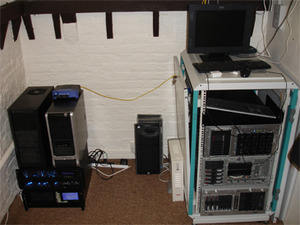
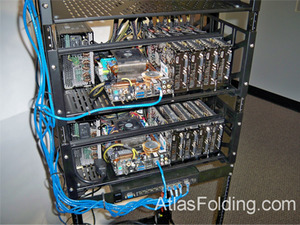
Left: One of our team's biggest contributor's farm, saspro's rigs include a Core 2 Quad Q6600 with three GeForce 8800 GTX/Ultra graphics cards sitting underneath three systems each built around the MSI K9A2 Platinum motherboard and four GeForce 8800 GTs. The right stack comprises three HP servers with a mixture of dual and quad-core Xeons running the CPU SMP client. Right: One of the top folders in the world, Atlas's farm consists dozens of rigs, each with multiple graphics cards. The current line-up includes 23 GeForce GTX 295s and 32 GeForce 9800 GX2s.
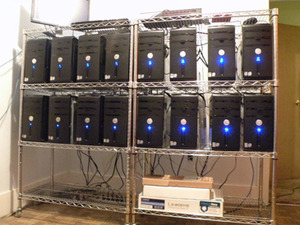
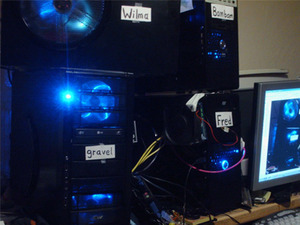
Left: A folding farm built and hosted by several Dell engineers. Right: Arthur Buse's farm comprises multiple PCs named after characters from the Flintstones.
If you’re lucky enough to have adequate resources to build a folding farm, it’s also worth thinking about where you’re going to locate them. For starters, multiple PCs folding 24/7 consume a lot of power and emit a lot of waste heat, so the location needs to be able to meet these needs. If you’re trying to cram as many PCs into as small an area as possible, it could also be worth considering rackmount cases. Although rackmount cases can be costly, they’re designed to stack one on top of another in a rackmount cabinet, so you can squeeze a large number of systems into a small space without worrying about it falling over. You can often find rackmounts for sale on eBay at a significant discount.
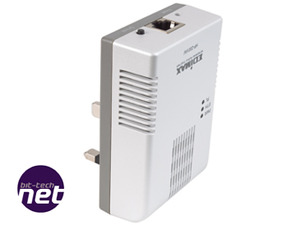 Another alternative is not to use a case at all. However, you’ll still need to find some method of keeping the systems apart, so that they don’t interfere with each other. A cost-effective choice is the wire mesh shelving racks you can find in most DIY superstores. Remember to sit the motherboards on a non-electrically conductive material (such as a sheet of wood) to prevent short circuits. Depending on the hardware configuration of each PC in the farm, you may also need to position several case or desk fans blowing over the systems to keep them cool. Caseless farms such as this are also prone to dust build-up, but it’s the most cost-effective way of housing multiple PCs.
Another alternative is not to use a case at all. However, you’ll still need to find some method of keeping the systems apart, so that they don’t interfere with each other. A cost-effective choice is the wire mesh shelving racks you can find in most DIY superstores. Remember to sit the motherboards on a non-electrically conductive material (such as a sheet of wood) to prevent short circuits. Depending on the hardware configuration of each PC in the farm, you may also need to position several case or desk fans blowing over the systems to keep them cool. Caseless farms such as this are also prone to dust build-up, but it’s the most cost-effective way of housing multiple PCs.If you don’t have space to locate the farm’s systems together, don’t worry, as there are several places you may not have considered. A loft or basement can make a great location for a folding farm. What’s more, with the advent of Ethernet over power devices such as the Edimax HP-2001AV (pictured right) which can be bought for around £40, which use the ringmain in your house as a LAN, you don’t need to worry about drilling holes in walls and floors for passing through cables.

MSI MPG Velox 100R Chassis Review
October 14 2021 | 15:04









Want to comment? Please log in.